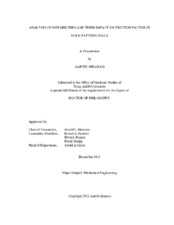| dc.contributor.advisor | Morrison, Gerald L | |
| dc.creator | Sekaran, Aarthi 1985- | |
| dc.date.accessioned | 2013-03-14T16:13:50Z | |
| dc.date.available | 2014-12-12T07:18:55Z | |
| dc.date.created | 2012-12 | |
| dc.date.issued | 2012-11-21 | |
| dc.date.submitted | December 2012 | |
| dc.identifier.uri | https://hdl.handle.net/1969.1/148122 | |
| dc.description.abstract | The determination of the leakage and consequently the friction factor is an important part of analyzing the flow through a seal. This is done experimentally by means of a flat plate tester, which allows for the simplified representation of the seal pattern on a flat plate surface tested under a range of clearances and pressure drops. The setup mounts a smooth plate opposite a second plate which may be smooth or have a roughened surface while the separation between plates is held constant. The present study analyzes the phenomenon of friction factor 'upset' ? wherein it was seen that as the pressure drop across the parallel plates is increased, there is a sudden increase in the friction factor (i.e. a decrease in flow rate) at a certain Reynolds number and for any further increase in the pressure differential, the friction factor shows the expected trend and decreases slowly. This phenomenon was initially believed to be an anomaly in the rig and was attributed to choking at an upstream flow control valve. The present author differs from that view and hypothesized that the reason for the abrupt change is linked to the flow mechanics of the system and the current study analyzes the same.
Preliminary analysis of available data has established that the cause for the 'upset' was not related to the switch from a normal mode resonance driven by the Helmholtz frequency of the cavities on the stator to a shear layer instability, as was seen earlier by Ha. The friction factor jump for this case is therefore proposed to be due to a change of the instability modes as the fluid passes over the cavities in the plate. A detailed analysis of the physics of the flow will be carried out via a numerical simulation using a Large Eddy Simulation (LES) model from ANSYS Fluent. Results will be validated through comparisons with experimental data from the flat plate test rig. | en |
| dc.format.mimetype | application/pdf | |
| dc.subject | Turbulence | en |
| dc.subject | Flow Instabilities | en |
| dc.subject | Hole-pattern seals | en |
| dc.subject | Computational Fluid Dynamics | en |
| dc.title | Analysis of Instabilities and Their Impact on Friction Factor in Hole-Pattern Seals | en |
| dc.type | Thesis | en |
| thesis.degree.department | Mechanical Engineering | en |
| thesis.degree.discipline | Mechanical Engineering | en |
| thesis.degree.grantor | Texas A&M University | en |
| thesis.degree.name | Doctor of Philosophy | en |
| thesis.degree.level | Doctoral | en |
| dc.contributor.committeeMember | Handler, Robert A | |
| dc.contributor.committeeMember | Ranjan, Devesh | |
| dc.contributor.committeeMember | Daripa, Prabir | |
| dc.type.material | text | en |
| dc.date.updated | 2013-03-14T16:13:50Z | |
| local.embargo.terms | 2014-12-01 | |


